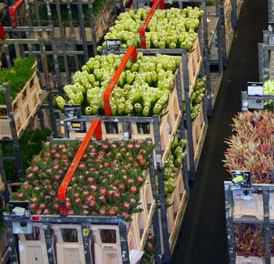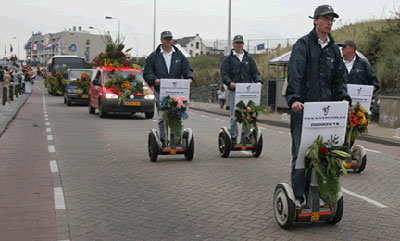Human Flower Project
Wednesday, March 22, 2006
Aal in a Day’s Work
Shopping for flowers? Bloemenveiling Aalsmeer, the world’s biggest flower market, should have what you’re looking for, especially if you’re male.

The auction room at Aalsmeer
Photo: Courtesy of Bloemenveiling Aalsmeer (VBA)
What began as a couple of flower trading posts in two Holland cafes is now the biggest flower auction on the planet: Bloemenveiling Aalsmeer.
Sales begin at 6:30 in the morning, as some 7000 growers from around the world put their gerbera daisies and birds of paradise before an audience of savvy buyers. By 9:30 a.m., more than 20 millions plants and cut flowers will have passed through the auction.
Rather than bidding prices up, buyers follow “Dutch Auction” practice. As each lot of flowers comes out on a stacked cart, the auction’s immense electronic clocks start the bidding at 100 (per stem), and tick backward. See a price you like? Press your button quickly. Via your headset, you let the auctioneer know how many stems you’ll buy at this price, he subtracts those flowers from the batch, and then the clock starts again, winding down, until the rest of those gladioli or larkspurs are sold. There are 13 clocks throughout the auction, all working simultaneously. “Per clock, some 1,500 transactions can be processed per hour.”
The huge complex, 999,000 sq. meters, is the largest commercial building in the world. The public areas are kept at about 12 C (54 F) so that roses and edgy traders all stay cool.
 Lilacs for sale in the Café De Drie Kolommen, 1912
Lilacs for sale in the Café De Drie Kolommen, 1912
Photo: Bloemenveiling Aalsmeer
We find it amazing that all this grew from a few local growers’ determination to cut out the middleman. The first auction of “export flowers” opened December 4, 1911 in Café Welkom, taking the name ‘Bloemenlust.’ A month later ‘Centrale Aalsmeerse Veiling’ (Central Aalsmeer Auction, CAV) was formed and began auctioning flowers in Café De Drie Kolommen. “Both auctions were thriving right from the beginning.”
It’s interesting to note that the auction trade took place in the same venues—the cafes—where that notorious market bubble tulipomania had expanded and burst two centuries earlier. Had the Dutch learned a lesson or was there something about the new trading system that kept the lid on? Perhaps some historian of economics will fill us in.
The Aalsmeer website provides loads of information about how the flower center developed. The two original auctions merged, we learned, in 1968, a decision “accelerated by the repeal of cultivation constraints and the explosive growth of the export of flowers and plants in the 1960s.” It seems the two marketing operations saw that all that volume would require a big new facility, which neither could afford to build alone.
 Stacking carts at Aalsmeer
Stacking carts at Aalsmeer
Photo: Steve Fazzio
Another stride forward came in 1975: “This year the stacking cart was introduced” making it possible to toodle many more blooms around at once. Today “130,000 auction stacking carts are in use” at Aalsmeer.
Others things, however, don’t appear to have changed much. Our correspondent and friend Cyndy Clark, who recently visited the flower market, reported that “There were no women in any of the auction rooms when I was there.” We wrote to Aalsmeer about the gender exclusivity of the auction floor and received this reply from Adrienne Lansbergen:
“Traditionally the buying job in the auction process is a men’s business. In the past because of the fact that the role of purchaser in the auction (very early in the morning and just for a few hours) was very often combined with another job at the export companies (‘heavy’ labour, for example loading the trucks and vans). Nowadays purchasing is a very stressy and specialized job. The purchasers of export companies start very early in the morning, between 05.00 and 06.00 a.m. Maybe that’s why the job is not that attractive for women (very often occupied during the morning hours with the children go to school).”
This said, Lansbergen notes, “A lot of women are working in the flower business: at the exporters in sales functions, in the shops, in the nursery and (also very often) in the management of nurseries.”
Cyndy replied, “Same old story, the women in the nursery!”
Sex roles in Holland’s flower business do appear to be distinct. Check out this fascinting research by anthropologist Alex Strating entitled “Kinship, Family and the Flower Trade in a Dutch Community.” Strating studied nearby Rijnsburg, exploring who does what in the flower trade.
“There is a strict division of labor between men and women. Since men are responsible for earning money and women have the responsibility of the household as their first priority.” The author found that most Rijnsburg traders marry local gals.

Rijnsburg dudes, rolling on segways down the Bloemencorso
Photo: We Move
“The trade is a stressful occupation with long working hours and every week, three of four nights away from home. When traders come home after a trip, they expect a haven in a stressful world. They also expect their wives to be able to cope with the ups and downs in earnings that are typical for the flower trade.
“Traders never told me that they choose a wife from Rijnsburg because she had these qualities. But when a trader with a wife from outside Rijnsburg runs into financial or marital problems, they generally explain this by the fact that outside wives can not cope with the demands of the trade whereas Rijnsburg wives can, because they have been brought up with it.”
Thank you Cyndy, Adrienne, and Alex, for all your insights into this fascinating intersection of flowers, gender roles and economies.




